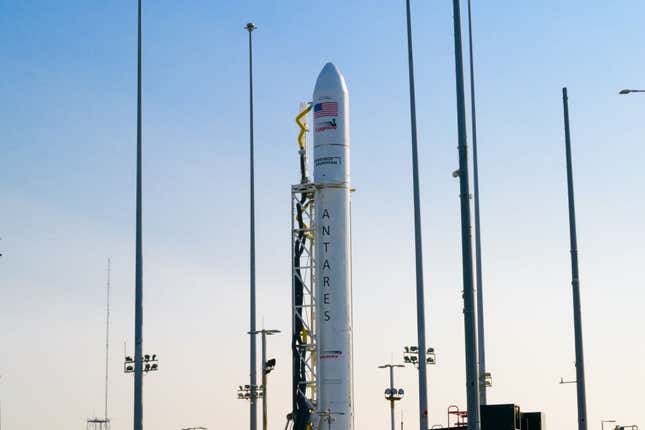Update: August 2, 8:45 a.m. ET: Northrop Grumman successfully executed its 19th resupply mission (NG-19) to the ISS under NASA’s Commercial Resupply Services-2 contract, using the company’s Antares 230+ rocket. The launch vehicle blasted off at 8:31 p.m. ET, sending the Cygnus cargo spacecraft, named S.S. Laurel Clark, on a journey to the orbital lab.
Original article follows.
The latest cargo mission by Northrop Grumman is set for tonight, marking the final flight of this rocket in its current configuration. You can catch the action live right here, or if you live along much of the U.S. East Coast, you can simply look up.
Launch of Northrop Grumman’s Cygnus cargo spacecraft to the International Space Station (ISS) is scheduled for Tuesday, August 1, at 8:31 p.m. ET. The mission, known as NG-19, is slated to take off from the Mid-Atlantic Regional Spaceport at Wallops Island, Virginia. Weather experts are predicting an 80% chance of favorable weather for the launch. As the name of the mission suggests, this will be Northrop Grumman’s 19th resupply mission to the ISS.
Live coverage of the launch will begin at 8:00 p.m. ET and will be broadcast on NASA’s website, the NASA app, and at the live feed provided above. People living near the mid-Atlantic region may be able to witness the rocket after liftoff, weather permitting of course. NASA Wallops provided a map showing where and when the Antares rocket might be visible.

For those who are local, the Wallops Visitor Center is scheduled to open at 5:30 p.m. ET. NASA Wallops recommends viewing locations on Chincoteague Island, including Robert Reed Park on Main Street and Beach Road, which spans the area between Chincoteague and Assateague Islands. Regardless of where you’re at, you can check out tonight’s Sturgeon Moon supermoon once the launch is complete.
Today’s launch attempt is noteworthy as it marks the final flight of this particular version of Antares, as it is equipped with Russian and Ukrainian components, as reported in SpaceNews. Following this, Northrop Grumman, working with Firefly Aerospace will transition to the new Antares 330, which is expected to be launched by summer 2025. It’s the end of the line for the Antares 230+, but the Antares 330 will be constructed from all-American-built components, in addition to featuring a more powerful first stage.
Packed on top of Antares is the Cygnus capsule, which will carry nearly 8,267 pounds (3,750 kilograms) of cargo, including crucial experiments, hardware, and supplies for the ISS crew. The scheduled launch would see Cygnus arrive at the ISS during the morning of August 4, with NASA’s coverage beginning at 4:30 a.m. ET. The capsule will stay attached to the orbital lab for at least three months.

NG-19 is the first Cygnus mission since NG-18 in November 2022, during which one solar array failed to deploy due to debris lodging in “one of the Cygnus solar array mechanisms,” the company explained at the time. The capsule still managed to reach the space station, but corrective actions have been implemented for NG-19 to hopefully prevent a recurrence.
Northrop Grumman has named the Cygnus spacecraft the S.S. Laurel Clark, honoring the late NASA astronaut Laurel Clark, who was part of NASA’s STS-107 mission and tragically lost her life on February 1, 2003, during Space Shuttle Columbia’s catastrophic reentry into Earth’s atmosphere.
Related article: In Photos: Remembering the Columbia Space Shuttle Disaster 20 Years Later
“It is the company’s tradition to name each Cygnus spacecraft in honor of an individual who has made substantial contributions to human spaceflight,” Northrop Grumman explained on its website. “Dr. Clark was an accomplished undersea medical officer and naval flight surgeon prior to her NASA career.” The company previously honored Sally Ride, the first U.S. woman in space.
For more spaceflight in your life, follow us on Twitter and bookmark Gizmodo’s dedicated Spaceflight page.

